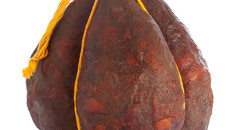Meats and Sausages
Skilandis
Skilandis, a Lithuanian sausage also known as Kindziuk in Polish is an almost legendary product, famous for its long keeping properties.
| Meats | Metric | US |
|---|---|---|
| Lean pork: leg, shoulder | 800 g | 1.76 lb |
| Fresh belly | 200 g | 0.44 lb |
Ingredients per 1000g (1 kg) of meat
| Salt | 33 g | 6 ½ tsp |
| Cure #2 | 5.0 g | 1 tsp |
| Sugar | 1.0 g | ¼ tsp |
| Pepper | 4.0 g | 2 tsp |
| Smashed garlic | 3.5 g | 1 clove |
| Alcohol, 95%, (American EverClear 190 proof), | 50 ml | 1.6 oz fl |
Instructions
- Cut meat and belly into 1.5” (30 mm) pieces and mix with pepper and smashed garlic.
- Fry salt briefly on a hot pan (removes moisture), stirring often. Rub salt thoroughly into the meat. Add sugar, cure #2 and alcohol. Pure alcohol evaporates rapidly removing moisture at the same time.
- Mix everything well together. Stuff firmly into pork stomach, bladder or 60 mm fibrous casing. Avoid creating air pockets. Reinforce with butcher’s twine: two loops lengthwise and loops across the casings every 2” (5 cm). Form 10-12 cm (4-5”) hanging loop on one end.
- Hang for at least 10 days in a cool, dry and ventilated area. This is when curing, drying and fermenting are taking place.
- Cold smoke (below 18º C, 64º F) for 3 weeks, applying smoke 3-4 hours daily. On the last day of smoking add juniper berries or juniper twigs into the fire.
- Dry for 2 months at 8° C (46° F) and 75% humidity. The sausage should lose about 35% of its original weight.
- Store in a dark, cool and dry place.
Notes
Originally the ingredients were stuffed into pork stomach or bladder. The stomach was sewn and the bladder was tied off with butcher twine. Then the casing was placed between two wooden boards and pressed together. The boards were tied with twine and hung. Original Skilandis was smoked with alder wood.


















